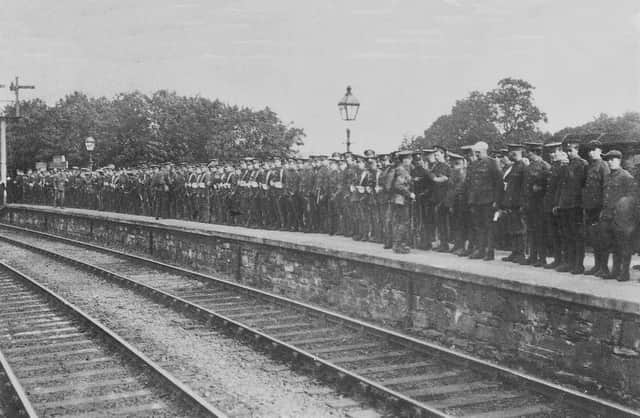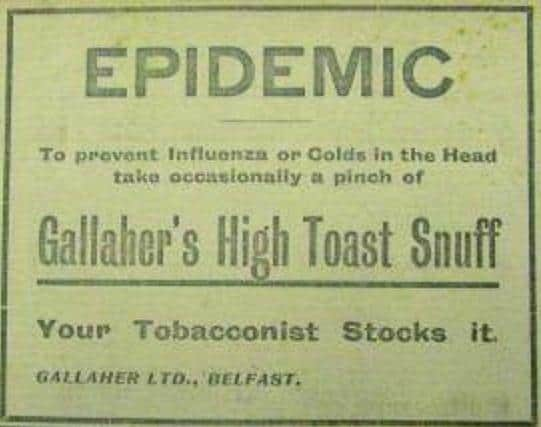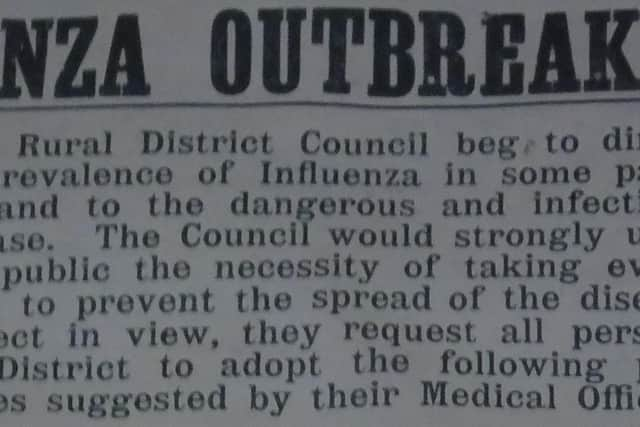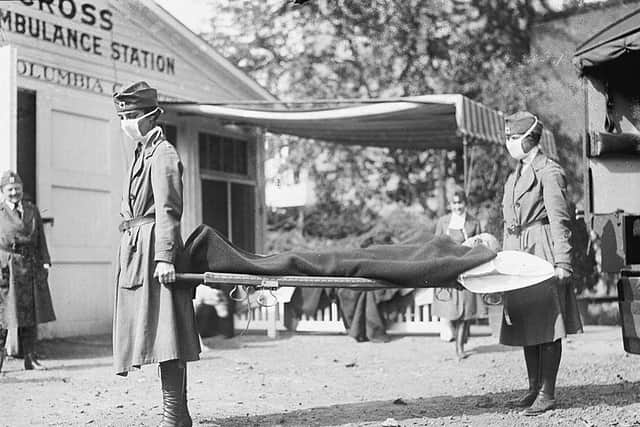Coronavirus? How the Great War brought an Influenza pandemic


The post-WWI pandemic (though it started during, if not before, the Great War) was originally called Spanish Flu (or the ‘Spanish lady’) because it was first recorded in Spain.
Some British and Irish soldiers called it ‘Flanders grippe’ and the Japanese called it ‘American influenza’ but its original source has never been given a definite date or location.
Advertisement
Hide AdAdvertisement
Hide AdThe government’s Chief Scientific Advisor Sir Patrick Vallance stressed on Tuesday that coronavirus “is very different” to the 1918 flu but on Roamer’s Armistice centenary pages two years ago details of its local impact were shared, with more today.


Universally regarded as ‘the greatest medical holocaust in history’ the 1918 pandemic infected 500 million people around the world, killing between 50 and 100 million.
While most who contracted the disease survived, it was young and healthy adults who were hardest hit, particularly in the summer and autumn, whereas flu is normally at its worst in winter.
“Since the period of the Great Famine with its awful attendant horrors of fever and cholera,” said Sir William J. Thompson MD, the wartime Registrar-General of Ireland, “no disease of an epidemic nature created so much havoc in any one year in Ireland as influenza in 1918”
Advertisement
Hide AdAdvertisement
Hide AdHaving spread quickly among their ranks, it was probably brought here by soldiers returning from war.


Sir William concluded that out of the 800,000 people in Ireland who caught the flu the full tally of deaths was probably over 16,000 - which may well have been an underestimation.
A young mother and her three daughters died within hours of each other in their family home near Moneymore.
In Belfast 100 tramway employees were absent with influenza during July 1918, and 120 in November.
Advertisement
Hide AdAdvertisement
Hide Ad“The influenza epidemic left the Enniskillen Workhouse in a state of chaos,” Fermanagh’s Impartial Reporter recounted, “corpses lay for three days unburied.”


Around 130 tram workers succumbed to the flu in Dublin where transport virtually ground to a halt.
A dancer died whist performing on a Belfast stage.
Most of Tipperary’s policemen caught it, Limerick’s cinemas closed their doors and a GAA final was postponed.
The 1918 flu came here in three waves - the first seemed to coincide with the arrival of US troops in the UK.
Advertisement
Hide AdAdvertisement
Hide AdThe second wave came between September and December 1918 and the third between February and April 1919. According to historian Gordon Lucy “the death toll from the first wave was relatively low. The second wave resulted in the highest death rates.
“The third wave was more lethal than the first but less so than the second.”
Flu deaths across the whole of Ireland “do not differ to any appreciable extent for each sex,” said Registrar-General Thompson, “being in the proportion of 100 males to 91 females.”
But the deaths of females “in the province of Ulster exceed those of males”, Sir William added, “doubtless the extensive employment of females in the factories and workshops of Belfast would account for the excess in the female mortality.”
Advertisement
Hide AdAdvertisement
Hide AdUlster followed the British pattern of spread, where the female influenza mortality was generally a little higher than for men, especially in the more industrial areas of the province. There were high proportions of women textile-workers in Belfast, Londonderry, Lurgan and Lisburn, and the overcrowded, hot, damp working conditions encouraged the spread of disease.
But most workplaces, however dry or cool, were susceptible.
“In Clones some places of business have had to close owing to the whole family being prostrated,” Fermanagh’s Impartial Reporter recounted, “and the police, usually immune from epidemics, have also fallen victim - nine of the Clones force being in bed ill.”
On 19 December 1918 the paper described Enniskillen’s workhouse: “Not only were the Master, Matron and Schoolmistress ill, but Nurse Macklin was also confined to her bed.
“The workhouse was full of influenza cases, and many patients had to lie on the floor. Three corpses lay for three days unburied.” Cures and remedies were suggested by experts, and advertised by manufacturers, in most of our newspapers.
Advertisement
Hide AdAdvertisement
Hide AdA News Letter advertisement headlined ‘Epidemic’ in June and July 1918 proffered an occasional pinch of ‘High Toast Snuff’ to prevent influenza.
An Irish Independent ad in December 1918 proposed Bovril, which was being stock-piled.
The Impartial Reporter published an article in October 1918:
“A few drops of Kurecold (Price 10d bottle) sprinkled on the handkerchief, is probably as good a preventative as anything - a little should also be inserted into each nostril. Taylor’s Influenza Mixture (1s. 6d Bottle) which has proved highly efficacious, should also be taken.”
Advertisement
Hide AdAdvertisement
Hide AdA Limavady Rural District Council poster from November 1918 warned the public to take “every possible precaution to prevent the spread of the disease.”
As well as highlighting the dangers of coughing and sneezing, the poster went somewhat further than the mere washing of hands.
It advocated “washing out nose and gargling mouth and throat with water” - which could be difficult today, whilst singing Happy Birthday twice!
Comment Guidelines
National World encourages reader discussion on our stories. User feedback, insights and back-and-forth exchanges add a rich layer of context to reporting. Please review our Community Guidelines before commenting.